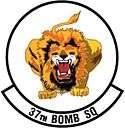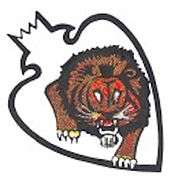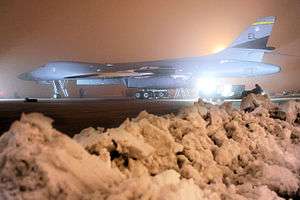37th Bomb Squadron
| 37th Bomb Squadron | |
|---|---|
|
37th Bomb Squadron Rockwell B-1 Lancer being prepared for Operation Odyssey Dawn at Ellsworth Air Force Base, S.D., 27 March 2011. | |
| Active |
13 June 1917 – 5 April 1919 1 September 1933 – 31 January 1938 1 February 1940 – 26 November 1945 19 May 1947 – 10 September 1948 10 May 1952 – 25 June 1958 1 July 1977 – 1 October 1982 1 January 1987 - Present |
| Country | United States |
| Branch | United States Air Force |
| Type | Strategic Bombing |
| Part of |
Global Strike Command 8th Air Force 28th Bomb Wing 28th Operations Group |
| Garrison/HQ | Ellsworth Air Force Base |
| Nickname(s) | Tigers |
| Mascot(s) | Billy |
| Engagements |
Doolittle Raid Operation Desert Fox Operation Enduring Freedom Operation Iraqi Freedom |
| Decorations |
|
| Insignia | |
| 37th Bomb Squadron emblem |
 |
The 37th Bomb Squadron (37 BS) is part of the 28th Bomb Wing at Ellsworth Air Force Base, South Dakota. It operates B-1 Lancer aircraft providing strategic bombing capability.
The squadron is one of the oldest in the United States Air Force, its origins dating to 13 June 1917, being organized at Kelly Field, Texas. The squadron deployed to England as part of the American Expeditionary Force during World War I. The squadron saw combat during World War II, and later became part of the Strategic Air Command (SAC) during the Cold War.
The squadron is an honorary member of the NATO Tiger Association
Mission
Provide rapid, decisive and sustainable combat airpower anytime, anywhere.
History
World War I
Established as a World War I Aero Squadron in Texas; deployed to France in September 1917. The squadron participated in aircraft construction from 1917–1918 and conducted flying training in 1918. Returned to the United States and inactivated in 1919.
Inter-war years
Reactivated in 1933 as a Pursuit Squadron, equipped with P-6 Hawks, A-8 Shrike and A-17A Nomad attack aircraft. Assigned to the Southeast Air District, flying coastal patrol missions from Langley Field, then Barksdale Field. Moved to Colorado and re-equipped with B-18 Bolo medium bombers; deploying to the Pacific Northwest.
World War II
The 37th It flew antisubmarine patrols from, December 1941–c. March 1942. The squadron also contributed aircrews for the Doolittle Raid on Tokyo, Japan on 6 April 1942. After the Japanese Attack on Pearl Harbor, the squadron flew antisubmarine patrols over the Northwest Pacific coast until May 1942.
After the Japanese invasion of the Aleutian Islands, squadron was deployed to the Alaska Territory. Flew combat missions during the Aleutian Campaign from forward bases on Adak and Amchitka during 1943 with B-25 Mitchells, attacking enemy targets on the occupied islands until their surrender.

Returned to the Continental United States in late 1943; re-equipped with B-24 Liberator heavy bombers and trained under Second Air Force. Deployed to European Theater of Operations (ETO); being assigned to Eighth Air Force in England. Engaged in various special operations missions as a CARPETBAGGER unit, assisting resistance forces by dropping supplies, weapons and personnel over Occupied Europe until August 1944. Engaged in PSYOPS warfare against Nazi Germany, dropping leaflets and flying other combat missions until the German capitulation in May 1945.
Most of squadron personnel demobilized in England during the summer of 1945, unit returned to the United States and being redesignated as a Very Heavy B-29 Superfortress bombardment squadron. War in Pacific Theater ended before unit completed training and the squadron was inactivated in October 1945.
Cold War
Reactivated in 1947 under Tactical Air Command but not manned or equipped. Inactivated in 1948. As a result of the Korean War, the squadron was reactivated again as part of Far East Air Force and equipped with B-26 Invader bombers equipped for night attacks. Carried out attacks on Communist forces primarily over South Korea until the Korean War armistice in 1953, then withdrawn to Japan where it remained until it was demobilized and administratively reassigned to Eglin #9 Field in 1955.
Re-equipped with Martin B-57A Canberra jet bombers and conducted evaluation testing of the aircraft at Eglin; transitioned to B-66B Destroyers in 1956, the first squadron to receive the new tactical bomber. Deployed to RAF Sculthorpe, England briefly in 1958 before returning to Eglin and performing more testing on B-66s with Jet Assisted Take Off (JATO) and until being inactivated due to budget cuts later in the year.
Reactivated as a B-52 Stratofortress squadron in 1977; inactivated in 1982 as part of the inactivation of the B-52D.
Modern era
Reactivated in 1987 as a B-1 Squadron
Lineage

- Organized as 37th Aero Squadron on 13 Jun 1917
- Demobilized on 15 Apr 1919
- Reconstituted, and re-designated 37th Pursuit Squadron, on 24 Mar 1923
- Activated on 1 Sep 1933
- Re-designated 37th Attack Squadron on 1 Mar 1935
- Inactivated on 31 Jan 1938
- Re-designated 37th Bombardment Squadron (Medium) on 6 Dec 1939
- Activated on 1 Feb 1940
- Re-designated 37th Bombardment Squadron, Medium, on 9 Oct 1944
- Inactivated on 26 Nov 1945
- Re-designated 37th Bombardment Squadron, Light, on 29 Apr 1947
- Activated on 19 May 1947
- Inactivated on 10 Sep 1948
- Re-designated 37th Bombardment Squadron, Light, Night Intruder, on 8 May 1952
- Activated on 10 May 1952
- Re-designated 37th Bombardment Squadron, Tactical, on 1 Oct 1955
- Inactivated on 25 Jun 1958
- Re-designated 37th Bombardment Squadron, Heavy, on 16 Jun 1977
- Activated on 1 Jul 1977
- Inactivated on 1 Oct 1982
- Activated on 1 Jan 1987
- Re-designated 37th Bomb Squadron on 1 Sep 1991.
Assignments
- Unknown, 13 Jun-Sep 1917
- Third Aviation Instruction Center, Sep 1917-Jan 1919
- Unknown, Jan-15 Apr 1919
- 18th Pursuit Group (attached to 8th Pursuit Group), 1 Sep 1933
- 2d Wing (attached to 8th Pursuit Group), 1 Mar 1935 – 31 Jan 1938
- 28th Composite Group, 1 Feb 1940
- 17th Bombardment Group, 23 Apr 1941 – 26 Nov 1945; 19 May 1947-10 Sep 1948; 10 May 1952 – 25 Jun 1958
- Attached to the 17th Bombardment Wing, 8 Jun 1957 – 25 Jun 1958
- 28th Bombardment Wing, 1 Jul 1977 – 1 Oct 1982; 1 Jan 1987
- 28th Operations Group, 1 Sep 1991-.
Stations
|
|
Aircraft
|
|
See also
References
![]() This article incorporates public domain material from the Air Force Historical Research Agency website http://www.afhra.af.mil/.
This article incorporates public domain material from the Air Force Historical Research Agency website http://www.afhra.af.mil/.
Bibliography
- Maurer, Maurer, ed. (1982) [1969]. Combat Squadrons of the Air Force, World War II (PDF) (reprint ed.). Washington, DC: Office of Air Force History. ISBN 0-405-12194-6. LCCN 70605402. OCLC 72556.
- USAF 34th Bomb Squadron History
- 28th Operations Group Fact Sheet



